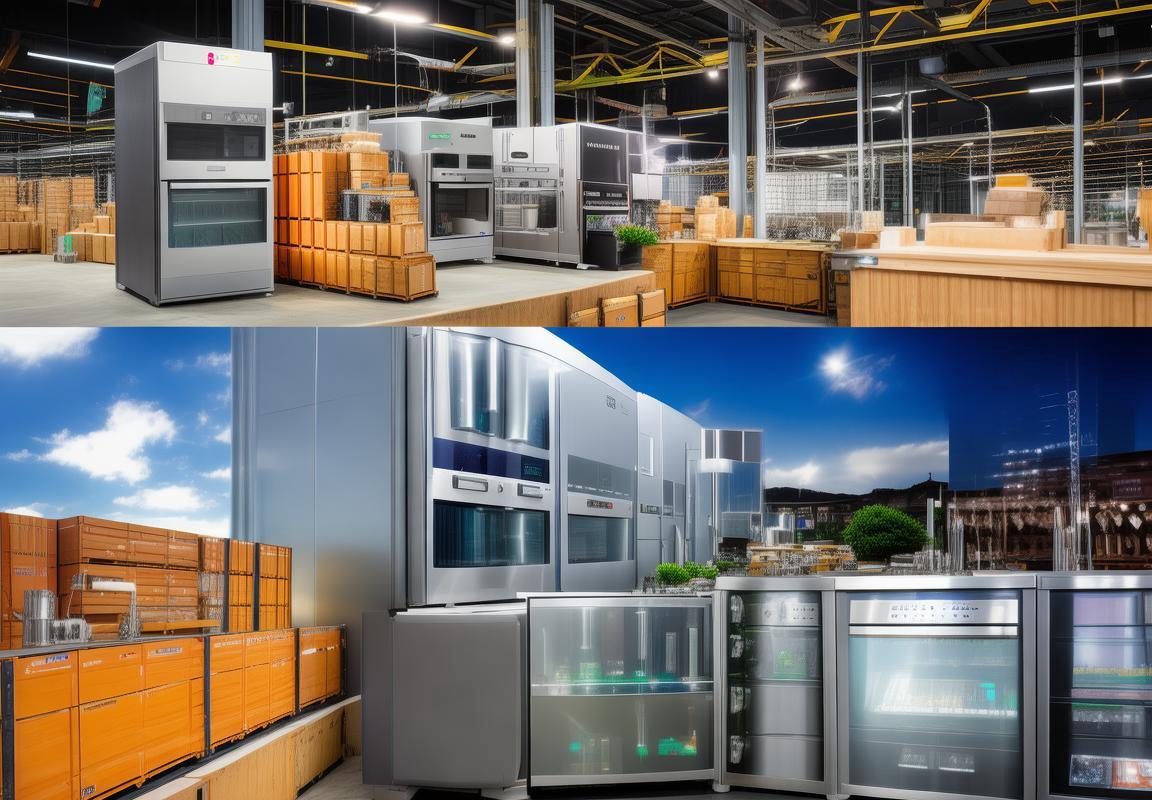In today’s globalized world, the landscape of the kitchen appliance industry is rapidly evolving, with OEM (Original Equipment Manufacturer) suppliers playing a pivotal role in driving innovation and meeting the diverse needs of consumers. As markets become more interconnected, understanding the intricacies of supply chain management and strategic partnerships is paramount. This article delves into the world of OEM suppliers, exploring the challenges they face, the opportunities that arise, and the strategic considerations that can make or break their success. Whether you’re a seasoned player in the industry or just entering the scene, the insights shared here aim to provide a comprehensive overview of what it takes to thrive in this dynamic and competitive marketplace.
Understanding DDP Rotterdam
DDP Rotterdam, or Delivered Duty Paid Rotterdam, is a term that encapsulates a crucial aspect of international trade, particularly within the European kitchen appliance market. This concept refers to a shipping arrangement where the seller is responsible for all costs and risks involved in transporting goods to the buyer’s location, including import duties and taxes. In the context of the bustling port of Rotterdam, DDP takes on an added layer of significance due to its strategic location and the thriving industry it supports.
Rotterdam, as the largest port in Europe, handles an impressive 51 million metric tons of cargo annually, making it a logistical powerhouse. When it comes to DDP, this port is not just a transit point; it’s a gateway for OEM (Original Equipment Manufacturer) suppliers looking to enter the European market. The term ‘DDP Rotterdam’ essentially means that the supplier is taking full responsibility for the goods until they are delivered to the buyer’s doorstep in Rotterdam.
The European kitchen appliance market is a dynamic and competitive space. Consumers in Europe are known for their preference for high-quality, energy-efficient, and stylish kitchen products. For OEM suppliers, navigating this market can be complex, but DDP Rotterdam simplifies the process by handling the complexities of customs clearance and import duties.
One of the primary advantages of choosing DDP Rotterdam is the streamlined logistics it offers. By consolidating all costs and responsibilities into one package, OEM suppliers can save time and resources. This is particularly beneficial for smaller companies that may not have the expertise or infrastructure to manage international shipping and customs procedures.
Moreover, the efficiency of the Rotterdam port means that goods can be delivered quickly, which is crucial in the fast-paced kitchen appliance industry. The port’s advanced handling facilities ensure that goods are processed swiftly, reducing the risk of delays and associated costs.
In the European market, there is a strong emphasis on compliance with local regulations and standards. DDP Rotterdam suppliers must ensure that their products meet all necessary safety and quality requirements. This can be a daunting task, but the port itself offers a range of services to facilitate compliance, from customs brokerage to quality inspections.
When it comes to the actual delivery process, DDP Rotterdam allows suppliers to focus on what they do best—manufacturing high-quality kitchen appliances. The seller is responsible for arranging transportation, insurance, and any necessary documentation, which means the buyer can simply receive the goods without the hassle of dealing with customs and shipping logistics.
For OEM suppliers, the choice to operate under DDP Rotterdam terms can also be influenced by the competitive landscape. By offering a comprehensive service package, suppliers can differentiate themselves from competitors and present a more attractive proposition to European buyers. This can be especially appealing in negotiations, as it reduces the buyer’s risk and responsibility.
It’s also worth noting that the European market for kitchen appliances is not just about selling to end consumers; it’s also a significant market for OEMs looking to supply components and sub-assemblies to European brands. DDP Rotterdam can be particularly advantageous in these scenarios, as it allows OEMs to establish a strong presence in Europe without the need for a local office or extensive infrastructure.
Another key aspect of DDP Rotterdam is the flexibility it offers. Suppliers can choose to deliver goods directly to the buyer or to a local warehouse or distribution center. This flexibility is important for managing inventory and ensuring that products are available when and where they are needed.
Furthermore, the port of Rotterdam is well-connected to the rest of Europe, making it easy for suppliers to reach various destinations within the continent. This is particularly beneficial for OEMs that need to distribute their products across multiple countries, as the logistics are simplified and the costs are more predictable.
In conclusion, DDP Rotterdam is a pivotal concept for OEM suppliers looking to enter the European kitchen appliance market. It simplifies the shipping process, reduces the buyer’s risk, and allows suppliers to focus on what they do best. With its strategic location, advanced logistics, and comprehensive service offerings, DDP Rotterdam is more than just a port; it’s a key partner in the success of OEM suppliers in Europe.

The European Kitchen Appliance Market Overview
The European kitchen appliance market has seen a remarkable transformation over the years, evolving from a simple necessity to a sophisticated blend of functionality, design, and sustainability. Here’s an in-depth look at the current landscape of this dynamic market.
In recent decades, there has been a significant shift in consumer preferences. Modern European kitchens are no longer just places for cooking; they have become hubs of entertainment and social interaction. This shift has led to a surge in demand for advanced kitchen appliances that offer convenience, efficiency, and aesthetic appeal.
Smart kitchen appliances are becoming increasingly popular, driven by the integration of technology. From smart refrigerators that can manage inventory and suggest recipes to ovens that can be controlled remotely via a smartphone, innovation is at the forefront of the market. These devices not only enhance the cooking experience but also provide valuable data to consumers, enabling them to make more informed choices about their health and lifestyle.
Energy efficiency is another crucial factor in the European kitchen appliance market. With rising energy costs and growing environmental concerns, consumers are gravitating towards appliances that are energy-saving and environmentally friendly. This has spurred the development of a wide range of products, from energy-efficient ovens and dishwashers to LED lighting solutions.
The market is also seeing a rise in personalized and modular kitchen appliances. Customers are looking for appliances that can be tailored to their specific needs and preferences, which has led to a variety of customizable options. For instance, kitchen islands with built-in appliances, such as cooktops and sinks, are becoming more common as they offer flexibility and adaptability to various kitchen layouts.
Another trend is the integration of kitchen appliances with home automation systems. The ability to control and monitor kitchen appliances remotely through smart home technology is becoming a standard feature in many new products. This integration not only adds convenience but also contributes to the overall smart home ecosystem.
In terms of product categories, the market is dominated by key segments such as refrigerators, dishwashers, ovens, and kitchen hoods. Each of these categories has its own unique set of trends and innovations. For example, refrigerators are now coming with features like touchless door openers, advanced air filters, and built-in water dispensers.
The European kitchen appliance market is highly competitive, with a mix of well-established brands and emerging players. Brands like Siemens, Bosch, and Miele are known for their premium quality and innovation, while newer companies are bringing fresh ideas and competitive pricing to the market.
Sustainability is a growing concern, and the market is responding with eco-friendly designs and manufacturing processes. From the use of recycled materials in appliances to the reduction of carbon footprints, manufacturers are increasingly focusing on sustainable practices.
Regulatory changes also play a significant role in shaping the market. The European Union has stringent regulations on energy efficiency and product safety, which all manufacturers must adhere to. These regulations have driven the industry towards more efficient and compliant products.
Despite the challenges, the European kitchen appliance market is expected to grow in the coming years. The aging population, changing lifestyles, and the rise of urbanization are all contributing factors. Additionally, the increasing focus on health and wellness is likely to drive demand for appliances that can help consumers cook healthier meals.
In conclusion, the European kitchen appliance market is characterized by a blend of technological innovation, sustainability, and consumer demand for personalized solutions. As the market continues to evolve, it will be interesting to see how these trends shape the future of kitchen appliances in Europe.

The Role of OEM Suppliers
In the dynamic world of kitchen appliance manufacturing, Original Equipment Manufacturers (OEMs) play a pivotal role in shaping the industry. These suppliers are the backbone of the market, providing the components and expertise that enable brands to create a wide array of kitchen appliances. Let’s delve into the multifaceted role of OEM suppliers in this sector.
OEMs are the architects of the product design process. They bring to the table a wealth of technical knowledge and engineering skills that are crucial for creating innovative and functional kitchen appliances. From the sleek design of a refrigerator to the precise mechanics of a coffee machine, OEMs ensure that every element is meticulously crafted to meet the highest standards of quality and efficiency.
Supply Chain Management is another critical aspect of the OEM’s role. They are responsible for sourcing raw materials, managing inventory, and coordinating production schedules. This logistical prowess ensures that manufacturers can keep up with market demands and maintain a steady flow of products. The efficiency of an OEM’s supply chain can significantly impact the speed at which new products reach the market.
Customization is a hallmark of the OEM supplier’s service. Many companies rely on OEMs to tailor their products to specific market needs or customer preferences. Whether it’s adapting a standard model to comply with local electrical standards or integrating advanced features for premium brands, OEMs are adept at providing customized solutions that resonate with consumers.
Quality Control is non-negotiable in the kitchen appliance industry. OEM suppliers are tasked with ensuring that every part and assembly meets stringent quality standards. This involves rigorous testing and quality assurance protocols to guarantee that the end product is reliable and safe. The reputation of a brand is often tied to the performance and durability of the appliances it produces, making the role of the OEM supplier indispensable.
Innovation is the lifeblood of the kitchen appliance market. OEMs are at the forefront of technological advancements, constantly seeking ways to improve existing products and develop new ones. They invest in research and development to introduce features like smart technology, energy efficiency, and user-friendly interfaces. This continuous innovation is what drives the market forward and keeps consumers engaged.
Collaboration with brands is a cornerstone of the OEM’s work. They often act as an extension of the manufacturer’s team, working closely with designers, engineers, and marketing specialists to bring products to life. This collaborative approach ensures that the final product aligns with the brand’s vision and meets the expectations of the target market.
Global Reach is a key advantage of working with OEM suppliers. They have the infrastructure and network to source materials from around the world, which can lead to cost savings and increased efficiency. Additionally, OEMs may have facilities in various regions, allowing them to cater to local demand and comply with international regulations.
Flexibility is another trait that sets OEM suppliers apart. They can quickly adapt to changes in the market, whether it’s a shift in consumer preferences or a sudden surge in demand. This agility is crucial in a fast-paced industry where trends can change rapidly.
Environmental Responsibility is increasingly important in the kitchen appliance sector. OEMs are tasked with designing and producing appliances that are not only efficient but also sustainable. This involves using eco-friendly materials, reducing energy consumption, and ensuring that the products are recyclable at the end of their life cycle.
Financial Stability is a prerequisite for any successful OEM supplier. They must be able to invest in new technologies, maintain inventory, and manage costs effectively. This financial stability ensures that OEMs can continue to deliver high-quality products and support their clients’ growth.
In conclusion, the role of OEM suppliers in the kitchen appliance market is multifaceted, encompassing design, production, quality control, innovation, and more. Their ability to adapt to market demands, collaborate effectively, and maintain high standards of quality is what allows them to be a crucial partner in the appliance manufacturing ecosystem.

Why Choose DDP Rotterdam as Your Supply Chain Entry Point?
DDP Rotterdam stands as a beacon for businesses seeking a strategic supply chain entry point in the European market. Its unique position and robust infrastructure make it an attractive destination for OEM (Original Equipment Manufacturer) suppliers looking to establish a strong presence in the region. Here are several compelling reasons why DDP Rotterdam is an optimal choice:
-
Strategic LocationDDP Rotterdam is situated in the heart of Europe, offering unparalleled access to a market that spans across the continent. Its proximity to major European cities ensures that OEM suppliers can efficiently reach their target audience, whether they are in Western, Central, or Eastern Europe.
-
Gateway to Global MarketsRotterdam is one of the largest ports in the world, handling a vast array of goods, including kitchen appliances. This port’s extensive network allows OEM suppliers to easily import and export their products, making it an ideal gateway to access global markets beyond Europe.
-
Advanced Logistics and InfrastructureThe logistics sector in Rotterdam is highly developed, with state-of-the-art facilities that support the movement of goods. This includes efficient customs clearance, warehousing, and distribution services, which are crucial for OEM suppliers to manage their supply chains effectively.
-
Cost-Effective OperationsRotterdam’s strategic location and well-developed infrastructure contribute to cost savings for OEM suppliers. The port’s efficiency reduces transportation costs, and the availability of skilled labor and resources means that suppliers can operate with greater cost-effectiveness.
-
Diverse Customer BaseThe European kitchen appliance market is diverse, with varying preferences and demands across different countries. DDP Rotterdam provides OEM suppliers with the opportunity to cater to this diversity by offering a platform to tailor their products to specific regional markets.
-
Market Trends and InnovationBeing at the forefront of global trade, Rotterdam is well-versed in the latest market trends and innovations. OEM suppliers can leverage this knowledge to stay ahead of the curve and introduce cutting-edge kitchen appliances to the European market.
-
Supportive Business EnvironmentThe Netherlands, where Rotterdam is located, offers a supportive business environment characterized by a stable economy, low corporate tax rates, and a favorable regulatory framework. This environment is conducive to the growth and expansion of OEM suppliers.
-
Strong Supply Chain PartnershipsRotterdam’s reputation as a global trading hub attracts a wide range of suppliers, manufacturers, and service providers. OEM suppliers can form strong partnerships with local businesses to enhance their supply chain capabilities and streamline operations.
-
Expertise in Handling Specialized GoodsThe port of Rotterdam has extensive experience in handling specialized goods, including fragile and high-value items like kitchen appliances. This expertise ensures that products are handled with care, reducing the risk of damage during transit.
-
Customization and FlexibilityOEM suppliers often require customization to meet the specific needs of their clients. DDP Rotterdam offers the flexibility to adapt to these requirements, whether it’s modifying product specifications or packaging to suit different market demands.
-
Access to Financing and Investment OpportunitiesFor OEM suppliers looking to expand or invest in new technologies, Rotterdam provides access to a variety of financing options and investment opportunities. The city’s financial institutions are well-versed in supporting international businesses.
-
Proximity to Key Manufacturing RegionsRotterdam’s location is not just advantageous for importing and exporting; it also puts OEM suppliers close to key manufacturing regions. This proximity can lead to shorter lead times and more efficient production processes.
-
Skilled WorkforceThe port of Rotterdam boasts a skilled workforce with expertise in various sectors, including logistics and manufacturing. OEM suppliers can tap into this talent pool to enhance their operational capabilities and product development.
-
Strong Focus on SustainabilityIn recent years, sustainability has become a crucial factor in the supply chain. Rotterdam is committed to reducing its environmental impact and has initiatives in place to support sustainable practices among its businesses, which can be a significant draw for eco-conscious OEM suppliers.
In conclusion, DDP Rotterdam offers a multitude of benefits that make it an excellent supply chain entry point for OEM suppliers. Its strategic location, advanced infrastructure, cost-effectiveness, and supportive business environment all contribute to creating a favorable climate for growth and success in the European kitchen appliance market.

Case Studies: Successful OEM Suppliers in DDP Rotterdam
In the bustling port of Rotterdam, a multitude of OEM (Original Equipment Manufacturer) suppliers have found a fertile ground for their businesses. Let’s delve into a few case studies that showcase the success stories of these suppliers in the DDP (Delivered Duty Paid) model.
One such story is that of “EcoGadgets,” a company specializing in eco-friendly kitchen appliances. Their journey began with a simple vision: to create sustainable products that cater to the environmentally conscious consumer. By partnering with local OEM suppliers in Rotterdam, EcoGadgets was able to produce high-quality, energy-efficient appliances that were not only cost-effective but also met the stringent European safety standards.
The collaboration with an OEM supplier in Rotterdam allowed EcoGadgets to tap into a network of skilled labor and advanced manufacturing technologies. This partnership enabled the company to scale up production quickly, ensuring that they could meet the growing demand for their products. The DDP model was particularly beneficial as it simplified the logistics process, allowing EcoGadgets to focus on marketing and distribution.
Another success story comes from “KitchNest,” a startup that designs and manufactures smart kitchen appliances. Their innovative products, such as the SmartOven and the KitchenAssistant, have gained traction in the market due to their user-friendly features and seamless integration with smart home systems. The journey of KitchNest highlights the importance of selecting the right OEM supplier.
In Rotterdam, KitchNest found a supplier that not only shared their commitment to innovation but also had the expertise to produce complex electronics. The supplier’s ability to handle both the hardware and software aspects of KitchNest’s products was crucial in bringing their vision to life. The DDP model ensured that KitchNest could deliver their products to customers without worrying about customs duties and taxes, thus maintaining a competitive edge in the market.
For “KitchenCrafters,” a family-owned business that has been in the kitchen appliance industry for generations, the decision to work with an OEM supplier in Rotterdam was a strategic move. The company specializes in handcrafted kitchenware, including high-end cookware and bakeware. Their supplier in Rotterdam provided them with access to state-of-the-art machinery that allowed them to maintain the quality of their products while increasing production capacity.
The DDP model was particularly advantageous for KitchenCrafters, as it allowed them to focus on their core competencies—design and craftsmanship—while leaving the logistics and customs complexities to their supplier. This partnership also enabled them to expand their market reach, as the supplier had established relationships with key distributors and retailers in Europe.
One cannot overlook the story of “GlobalGourmet,” a company that has made a name for itself by producing high-end kitchen appliances for professional chefs and gourmet enthusiasts. Their products, such as the Chef’sStation and the ProBaker, are known for their precision and durability. The path to success for GlobalGourmet involved finding the right OEM supplier in Rotterdam.
The supplier in Rotterdam was able to replicate the intricate designs of GlobalGourmet’s products with remarkable accuracy. The DDP model played a significant role in GlobalGourmet’s success by ensuring that their products were delivered to customers worldwide without any additional costs or delays. This allowed the company to maintain its reputation for quality and reliability.
In the case of “GreenGears,” an OEM supplier that specializes in energy-saving kitchen appliances, their partnership with a local manufacturer in Rotterdam was pivotal. The company’s focus on sustainability led them to develop a range of eco-friendly appliances, such as the SolarCooker and the GreenKettle.
The supplier in Rotterdam not only shared GreenGears’ commitment to the environment but also had the capability to produce these products efficiently. The DDP model provided GreenGears with a streamlined process, allowing them to concentrate on marketing and promoting their eco-friendly brand. This strategic move has helped GreenGears to carve out a niche in the market for sustainable kitchen appliances.
These case studies of successful OEM suppliers in DDP Rotterdam illustrate the benefits of choosing this port as a supply chain entry point. From access to advanced manufacturing technologies and skilled labor to simplified logistics and customs processes, the port of Rotterdam has proven to be a valuable partner for companies looking to thrive in the competitive European kitchen appliance market.

Challenges and Opportunities
Navigating the complexities of the global market, OEM (Original Equipment Manufacturer) suppliers often face a myriad of challenges and opportunities. These dual aspects are intricately woven into the fabric of their operations, shaping their strategies and outcomes.
In the realm of OEM supply, one significant challenge is the need for constant innovation. Customers demand cutting-edge technology, and OEMs must continuously evolve their products to meet these expectations. This means investing in research and development, which can be a substantial financial and time commitment.
The challenge of quality control is another hurdle. Ensuring that every product meets the highest standards is crucial, especially when dealing with international markets. OEMs must establish rigorous quality assurance protocols and maintain them across different production facilities, which can be difficult to manage.
On the flip side, the opportunity for growth is immense. The global kitchen appliance market, for instance, is witnessing a surge in demand, driven by urbanization and the increasing focus on convenience and efficiency in home cooking. This presents OEMs with a chance to tap into new markets and expand their customer base.
One key opportunity lies in customization. Consumers are looking for appliances that not only perform well but also fit their personal style and kitchen layout. OEMs that can offer tailored solutions stand to gain a competitive edge.
Another opportunity is the rise of smart appliances. As technology becomes more integrated into everyday life, the demand for smart kitchen appliances is on the rise. OEMs that can develop and produce these innovative products are well-positioned to capture a significant share of the market.
However, with opportunities come challenges. One such challenge is the rapid pace of technological advancements. Keeping up with these changes requires a significant investment in training and technology, which can be costly for smaller OEMs.
Moreover, the challenge of market diversification cannot be overlooked. OEMs must be prepared to adapt to the unique needs and preferences of various international markets. This means understanding local regulations, cultural nuances, and consumer behavior, which can be a complex task.
In terms of supply chain management, OEMs face the challenge of balancing cost efficiency with quality. They must find the right balance between sourcing components from different regions of the world to optimize costs without compromising on the end product’s quality.
Despite these challenges, there are numerous opportunities for OEMs to thrive. One such opportunity is the increasing emphasis on sustainability. As consumers become more environmentally conscious, there’s a growing demand for appliances that are energy-efficient and eco-friendly. OEMs that can meet these demands are likely to see a boost in their market share.
Additionally, the opportunity to collaborate with other companies cannot be underestimated. Partnerships can lead to the development of new products, sharing of resources, and even the creation of entirely new markets. By combining strengths and expertise, OEMs can create innovative solutions that stand out in a crowded marketplace.
Furthermore, the rise of e-commerce presents a unique opportunity for OEMs. By leveraging online platforms, they can reach a wider audience and offer a more personalized shopping experience. This shift also allows for more direct interaction with customers, providing valuable feedback that can inform product development.
In conclusion, the landscape of OEM supply is marked by a dynamic interplay of challenges and opportunities. While there are obstacles to overcome, such as the need for innovation, quality control, and market diversification, there are also numerous avenues for growth and success. By embracing these challenges and capitalizing on the opportunities, OEMs can position themselves as leaders in their industry and continue to meet the evolving demands of the global market.

Future Outlook and Predictions
The landscape of the kitchen appliance industry is rapidly evolving, and with it comes a wave of opportunities and challenges that are reshaping the future of the market. Innovations in technology, changing consumer preferences, and global economic shifts are all playing a pivotal role in shaping the future outlook for OEM suppliers.
Innovation in Smart AppliancesSmart kitchen appliances are becoming increasingly popular, driven by the rise of the Internet of Things (IoT). As these devices integrate advanced features like voice control, connectivity, and energy efficiency, OEM suppliers must stay ahead by investing in research and development to offer cutting-edge products that cater to the evolving needs of consumers.
Energy Efficiency and SustainabilityEnergy conservation and sustainability are at the forefront of consumer concerns. With the growing demand for eco-friendly products, OEM suppliers are under pressure to produce appliances that consume less energy and have a lower carbon footprint. This shift not only aligns with global environmental goals but also presents a significant opportunity for suppliers to differentiate their offerings.
Market DiversificationThe kitchen appliance market is no longer confined to traditional regions. Emerging markets, such as those in Asia and Africa, are witnessing a surge in demand for affordable and efficient appliances. OEM suppliers that can successfully diversify their markets and adapt to these new consumer bases will find ample opportunities for growth.
Technological IntegrationThe integration of technology beyond the smart features of appliances is expected to become more prevalent. This includes the use of materials science to create appliances that are not only functional but also durable and aesthetically pleasing. Suppliers that can harness these advancements will have a competitive edge.
Regulatory ChangesGovernment regulations can significantly impact the appliance industry, especially in terms of safety and environmental standards. Suppliers must be prepared to navigate these changes, ensuring compliance while also looking for innovative ways to meet new requirements without compromising on quality or cost.
Global Supply Chain DisruptionsThe disruptions caused by events like the COVID-19 pandemic have highlighted the vulnerabilities of global supply chains. Suppliers that rely on a robust and resilient supply chain network will be better equipped to handle future disruptions. This means diversifying suppliers, optimizing logistics, and investing in technology to streamline operations.
Consumer Behavior ShiftsConsumer behavior is changing rapidly, with a growing emphasis on health and wellness. Kitchen appliances that support these trends, such as air purifiers, water filters, and appliances that promote healthy cooking methods, are likely to see increased demand. Suppliers must stay attuned to these shifts and adapt their product lines accordingly.
E-commerce GrowthThe rise of e-commerce has transformed the way consumers purchase kitchen appliances. Online sales are becoming a significant channel, and suppliers that can effectively market and sell their products through digital platforms will tap into a vast and growing market.
Partnerships and CollaborationsCollaborations between OEM suppliers and technology companies, design firms, and even foodservice providers are becoming more common. These partnerships can lead to groundbreaking innovations and open up new markets. Suppliers that are open to collaboration will be better positioned to anticipate and capitalize on emerging trends.
The future of the kitchen appliance industry is marked by a blend of challenges and opportunities. Suppliers that can innovate, adapt, and collaborate effectively will be at the forefront of this dynamic market, driving growth and success in an era of continuous change.

Key Considerations for OEM Suppliers
Navigating the complexities of the OEM (Original Equipment Manufacturer) landscape requires careful consideration of several key factors. From quality control to market trends, here’s a detailed look at the critical aspects OEM suppliers should keep in mind:
-
Market Research and Trends AnalysisUnderstanding the latest market trends is crucial. OEM suppliers must stay abreast of consumer preferences, technological advancements, and regulatory changes. By analyzing these trends, suppliers can anticipate shifts in demand and adjust their product lines accordingly.
-
Quality Assurance and ComplianceQuality is paramount in the OEM sector. Suppliers must ensure that their products meet stringent quality standards and comply with international regulations. This includes adherence to safety standards, environmental regulations, and certifications like ISO or CE marking.
-
Supply Chain ManagementEfficient supply chain management is vital for OEM suppliers. This involves selecting reliable suppliers for raw materials, maintaining inventory levels, and managing logistics to ensure timely delivery. Suppliers must also be prepared to adapt to supply chain disruptions, such as those caused by natural disasters or global pandemics.
-
Customization and FlexibilityOEM suppliers often need to cater to the unique requirements of their clients. This means offering customization services that can range from minor design adjustments to complete product reconfigurations. Flexibility in production and delivery is essential to meet these demands without compromising quality.
-
Cost-Effective ManufacturingCost control is a significant factor for OEM suppliers. Finding a balance between quality and cost is crucial. Suppliers must explore cost-saving opportunities without compromising on the quality of their products or the reputation of their clients.
-
Innovation and R&DContinuous innovation is key to staying competitive. OEM suppliers should invest in Research and Development (R&D) to create new products, improve existing ones, and keep up with technological advancements. This can include developing new materials, manufacturing processes, or incorporating smart technology into products.
-
Sales and Marketing StrategyEffective sales and marketing are essential for OEM suppliers to reach their target market. This involves understanding the marketing channels and strategies that work best for the specific industry and product. Building strong relationships with distributors, retailers, and end-users is also crucial for long-term success.
-
Intellectual Property ProtectionOEM suppliers must protect their intellectual property rights to ensure they can maintain a competitive edge. This includes securing patents, trademarks, and copyrights for their products and designs. It’s also important to have agreements in place to prevent unauthorized copying or use of intellectual property.
-
Environmental ResponsibilityAs sustainability becomes a growing concern, OEM suppliers need to consider the environmental impact of their operations. This includes using eco-friendly materials, minimizing waste, and reducing energy consumption. Adapting to green manufacturing practices can also open up new markets and opportunities.
-
Legal and Regulatory ComplianceNavigating the legal and regulatory landscape is complex. OEM suppliers must stay informed about international trade laws, import/export regulations, and local business practices. This includes understanding customs duties, taxes, and trade agreements to ensure compliance and avoid penalties.
-
Training and DevelopmentInvesting in the training and development of staff is crucial for maintaining high standards. Suppliers should provide ongoing training to keep employees up-to-date with the latest technologies, manufacturing processes, and quality control measures.
-
Customer Service and SupportProviding excellent customer service and support is vital for building long-term relationships with clients. This includes offering technical assistance, after-sales support, and quick response to customer inquiries or issues.
-
Financial StabilityFinancial stability is a for any successful OEM supplier. Managing cash flow, securing financing when needed, and maintaining a healthy balance sheet are essential for sustaining operations and investing in growth opportunities.
-
Ethical Business PracticesEthical conduct is non-negotiable. OEM suppliers must adhere to ethical business practices, including fair labor standards, transparent dealings, and a commitment to social responsibility.
By carefully considering these key factors, OEM suppliers can position themselves for success in a dynamic and competitive market. Balancing quality, innovation, and customer satisfaction while navigating the complexities of the global supply chain is the path to sustainable growth and profitability.

The Importance of Local Partnerships
Navigating the complexities of the global market, Original Equipment Manufacturers (OEMs) often find that forging strong local partnerships is a cornerstone of their success. These collaborations are not just about translating business deals into reality; they are about understanding and adapting to local nuances, cultures, and regulations. Here’s a deeper look into why local partnerships are crucial for OEM suppliers.
In a world where supply chains are more intricate than ever, the role of local partners cannot be overstated. They serve as gatekeepers to local markets, providing invaluable insights into consumer preferences, market trends, and regulatory requirements. For OEM suppliers, this can mean the difference between a product that fails to resonate with local consumers and one that becomes a market leader.
Understanding Local Consumer NeedsLocal partnerships allow OEM suppliers to tap into a wealth of knowledge about the local consumer. This includes understanding local tastes, preferences, and even the specific features that a product might need to cater to a certain demographic. For instance, a kitchen appliance designed for a European market might require different functionalities compared to one intended for the Asian market. Local partners can provide this nuanced understanding, ensuring that products are tailored to meet these diverse needs.
Navigating Complex Regulatory LandscapesRegulatory compliance is a significant hurdle for OEM suppliers, especially when entering new markets. Local partnerships can ease this process by having a deep understanding of the regulations and standards in place. This can range from product safety certifications to environmental compliance and import/export requirements. By working with local entities that are well-versed in these regulations, OEMs can avoid costly fines and delays.
Building Trust and CredibilityA well-established local partner can significantly boost an OEM’s credibility in a new market. Local consumers and businesses are often more comfortable doing business with companies that have a local presence and a partner they trust. This trust is built over time through consistent performance, adherence to local business practices, and a commitment to the community.
Enhancing Distribution and LogisticsThe logistics of getting a product from the factory to the end consumer can be daunting. Local partners can offer expertise in distribution channels, warehousing, and transportation, ensuring that products are delivered efficiently and cost-effectively. They can also help navigate the complexities of local supply chains, ensuring that OEM suppliers can scale their operations effectively.
Adapting to Local Business PracticesEach region has its own set of business practices, from negotiation tactics to sales and marketing strategies. Local partners understand these nuances and can guide OEM suppliers on how to navigate them successfully. This includes everything from understanding the importance of personal relationships in some markets to the significance of local holidays in business operations.
Supporting Innovation and Product DevelopmentLocal partnerships can also be a source of innovation. By collaborating with local businesses, OEM suppliers can gain access to new technologies, materials, and design ideas that might not be readily available in their home country. This can lead to the development of more competitive and innovative products that resonate with local consumers.
Mitigating RisksThe global market is fraught with risks, from economic downturns to geopolitical tensions. Local partners can help OEM suppliers mitigate these risks by providing a buffer against market fluctuations and by offering alternative supply chain options. This can be particularly important in regions that are prone to political instability or natural disasters.
Cultivating a Sustainable Business ModelIn today’s world, sustainability is not just a buzzword; it’s a business imperative. Local partnerships can help OEM suppliers implement sustainable practices that align with local expectations and regulations. This can include using eco-friendly materials, reducing waste, and engaging in community development initiatives.
In summary, local partnerships are not just a strategic advantage for OEM suppliers; they are essential for long-term success in the global market. By leveraging the expertise, networks, and insights of local partners, OEMs can navigate the complexities of international business more effectively, ultimately leading to stronger market positions and sustainable growth.

Conclusion
In reflecting on the journey of OEM suppliers in the ever-evolving landscape of the global market, it becomes apparent that the path to success is paved with a blend of strategic foresight, adaptability, and a keen understanding of the nuances within each market. The challenges and opportunities that these suppliers face are not just about navigating legal and logistical hurdles, but also about embracing innovation and fostering strong local partnerships.
The complexities of international trade demand a nuanced approach, where suppliers must balance the pursuit of efficiency with the need for compliance. This delicate balance is often achieved through a network of local partners who understand the cultural, legal, and business intricacies of the regions they operate in. From regulatory frameworks to customer preferences, these partnerships serve as a bridge between global aspirations and local realities.
In the realm of OEM suppliers, the quest for innovation is not just about developing new products; it’s about creating solutions that resonate with the end-users. This requires a deep dive into market research, consumer insights, and the ability to anticipate future trends. By staying ahead of the curve, OEM suppliers can not only meet but exceed customer expectations, ensuring their products remain competitive in a rapidly changing landscape.
The importance of local partnerships cannot be overstated. They are the bedrock of successful market entry and growth. These alliances provide OEM suppliers with access to local expertise, networks, and resources that are instrumental in navigating the complexities of different markets. From language barriers to currency exchange, these partnerships can mitigate risks and unlock new opportunities that might otherwise remain out of reach.
Moreover, local partnerships often lead to better product localization. Understanding the nuances of local markets allows OEM suppliers to tailor their products to meet specific needs and preferences. This level of customization can be the difference between a product that sells and one that fails to resonate with consumers.
The journey of an OEM supplier is also marked by the need for continuous improvement. This means not just improving the quality of products, but also enhancing the efficiency of operations. Embracing technology, such as advanced manufacturing techniques and supply chain management tools, can lead to significant gains in productivity and cost-effectiveness.
As we look towards the future, the landscape for OEM suppliers is both promising and complex. Globalization continues to bring new markets to the fore, but it also means facing increased competition. Suppliers must be agile and ready to pivot their strategies in response to market shifts and economic fluctuations.
The importance of compliance cannot be underestimated. As regulations become more stringent across the globe, OEM suppliers must ensure that their operations are in full compliance with local laws and international standards. This not only protects the supplier’s reputation but also fosters trust with customers and partners.
In conclusion, the role of OEM suppliers is multifaceted, requiring a combination of technical expertise, market understanding, and strategic planning. The challenges they face are substantial, but so are the opportunities for growth and innovation. By leveraging the strengths of local partnerships, embracing technological advancements, and maintaining a focus on compliance and quality, OEM suppliers can chart a course towards sustained success in a dynamic and competitive global market.